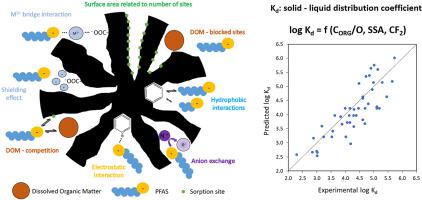Chemosphere ( IF 8.1 ) Pub Date : 2022-04-29 , DOI: 10.1016/j.chemosphere.2022.134733 Joel Fabregat-Palau 1 , Miquel Vidal 1 , Anna Rigol 1

|
The use of carbon-rich sorbents to remove and/or immobilize perfluoroalkyl substances (PFAS) in contaminated environmental scenarios is attracting increasing interest. The identification of key sorbent properties responsible for PFAS sorption and the development of models that can predict the distribution coefficients (Kd) for PFAS sorption in these materials are crucial in the screening of candidate materials for environmental remediation. In this study, sorption kinetics, sorption isotherms, and the effects of pH, calcium concentration and dissolved organic carbon (DOC) content on PFAS sorption were evaluated in four representative carbon-rich materials: two biochars with contrasting properties, a compost, and charcoal fines rejected by the metallurgical industry. Subsequently, the sorption of seven PFAS with numbers of fluorinated carbons ranging from 4 to 11 was evaluated in a total of ten carbon-rich materials, including activated carbons, so as to build up a Kd prediction model. The sorption of PFAS increased with greater fluorinated chain length, suggesting that hydrophobic interactions play a major role in sorption and electrostatic interactions a minor one. These results were confirmed by a principal component analysis, which revealed that the CORG/O molar ratio and the specific surface area of the material were the two main sorbent properties affecting PFAS sorption. Furthermore, the DOC content in solution had a negative effect on PFAS sorption. Using this information, a simple Kd prediction model applicable to a wide range of materials and PFAS was developed, using only a few easily-derived physicochemical properties of sorbent (CORG/O molar ratio and SSA) and PFAS (number of CF2), and was externally validated with data gathered from the literature.
中文翻译:

检查生物炭和其他富碳材料中全氟烷基物质 (PFAS) 的吸附
在受污染的环境中使用富碳吸附剂去除和/或固定全氟烷基物质 (PFAS) 引起了越来越多的兴趣。确定导致 PFAS 吸附的关键吸附剂特性以及开发可预测分布系数 (K d) 用于这些材料中的 PFAS 吸附对于筛选用于环境修复的候选材料至关重要。在这项研究中,在四种代表性的富碳材料中评估了吸附动力学、吸附等温线以及 pH、钙浓度和溶解有机碳 (DOC) 含量对 PFAS 吸附的影响:两种具有对比特性的生物炭、一种堆肥和木炭冶金行业拒绝罚款。随后,在包括活性炭在内的总共 10 种富碳材料中评估了 7 种氟化碳数量为 4 到 11 的 PFAS 的吸附,以建立 K d预测模型。PFAS 的吸附随着氟化链长度的增加而增加,这表明疏水相互作用在吸附中起主要作用,而静电相互作用则次要。这些结果通过主成分分析得到证实,表明 C ORG / O 摩尔比和材料的比表面积是影响 PFAS 吸附的两个主要吸附剂性质。此外,溶液中的 DOC 含量对 PFAS 的吸附有负面影响。利用这些信息,开发了适用于各种材料和 PFAS的简单 K d预测模型,仅使用吸附剂(C ORG /O 摩尔比和 SSA)和 PFAS(CF 2),并使用从文献中收集的数据进行了外部验证。















































 京公网安备 11010802027423号
京公网安备 11010802027423号